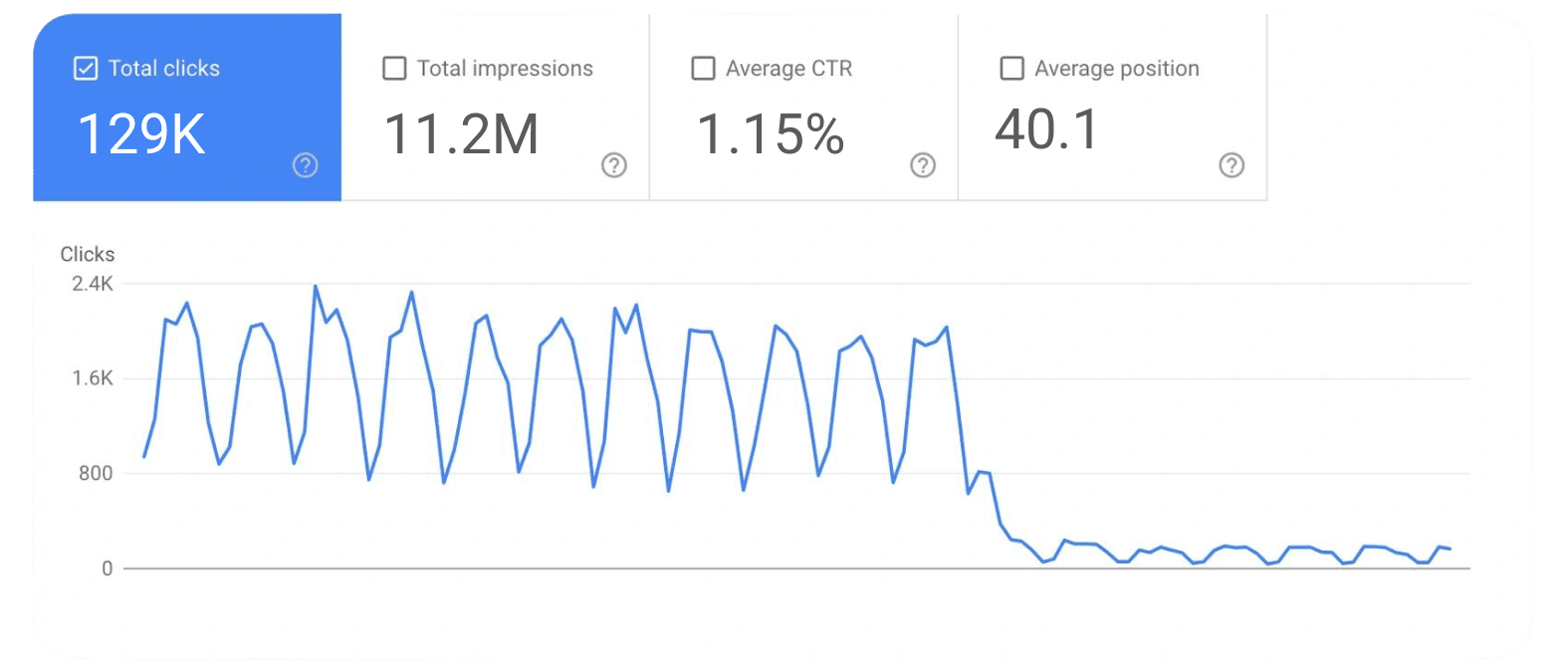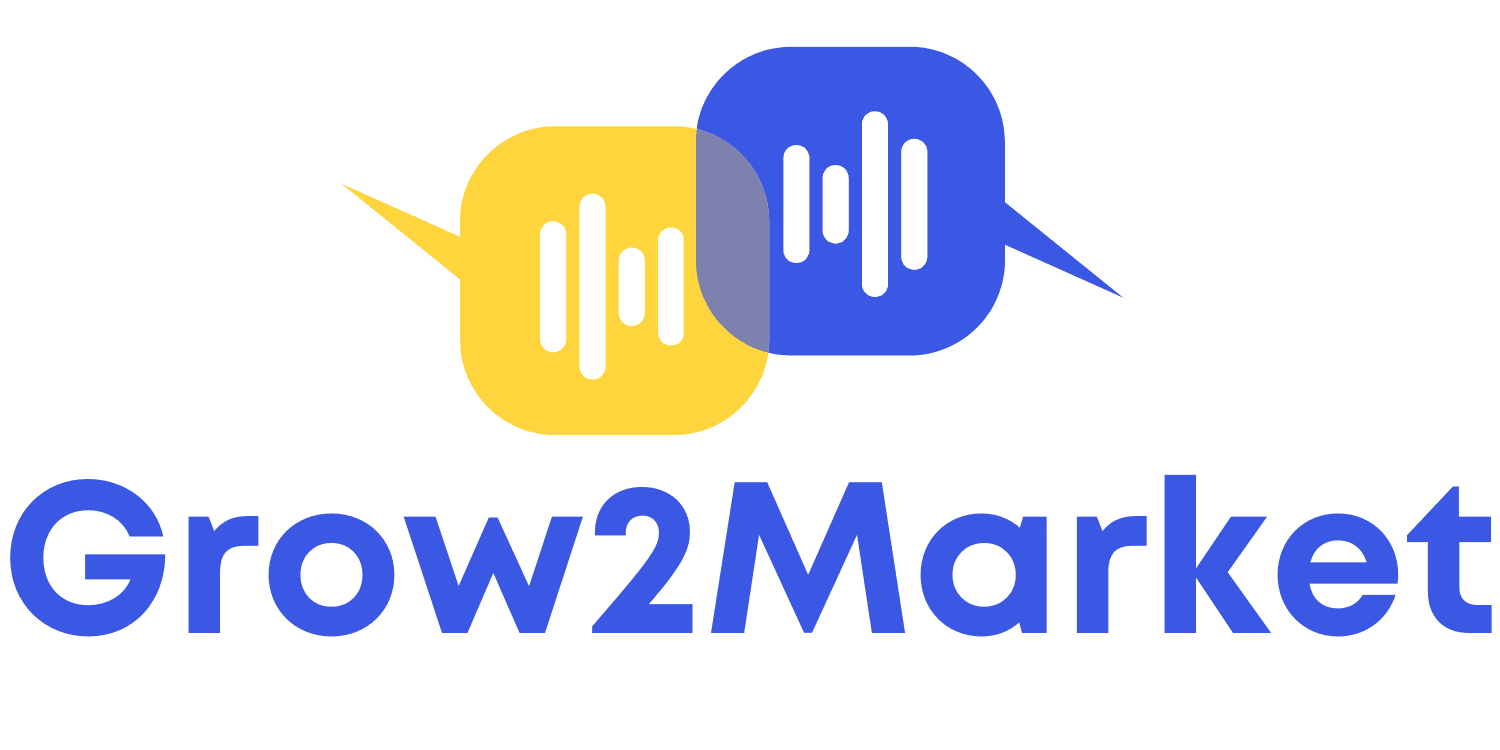You’ve tanked your Google ranking – what now?
Search engine results pages (SERPs) are incredibly competitive. Your content must be high-quality and offer genuine value to achieve and maintain top SERP positions. However, low-quality content can lead to penalties from Google, which eventually results in a significant decrease in search ranking.
In this blog post, we provide a step-by-step guide on how to reclaim your SERP positions if they have dropped due to poor-quality AI-generated content or substandard human copywriting.
Table of Contents
First of all, access the damage
Google Search Console provides valuable insights into how your website content is performing, including metrics like click-through rates, impressions, and search rankings. The screenshot below from Google Search Console shows a significant decline in clicks, indicating potential issues with the content.

To better understand how and where the content quality has faltered, you should take the following steps:
1. Conduct an SEO audit
Use tools like Google Analytics and SE Ranking to analyse drops in traffic, increased bounce rates, or lowered engagement metrics.
2. Use Google Search Console
Check for any alerts or warnings from Google about your site’s content.
3. Assess content quality
Review the content published during the period when the number of clicks dropped. Check if it is off-topic, overly stuffed with keywords, or generally lacks substance and relevance.
4. Evaluate the use of AI
Analyse whether the AI-generated content aligns with your brand’s tone, is factually accurate, and provides value to the reader.
Address issues with AI-driven content
AI can be a powerful tool in content creation, but poor implementation or misuse can undermine your website’s search performance and user experience.
- Review AI output: Before posting AI-generated content, review the copy to check for quality and factuality.
- Enhance training data: Sometimes, poor AI outputs are the result of inaccurate AI prompts. To improve the quality of output, give AI clear and concise instructions.
- Add human touch: Strike a balance between AI and human input. A high-quality AI platform can give great results, but a content plan should include human copy too.
Sick of generic AI writing?
Try CopyReadyNow! Generate SEO-optimised, quality content in seconds without expensive AI subscriptions and complex prompts. Sign up today and get 30 FREE credits!
Improve human-crafted content
When your Google rankings suffer due to poor human copywriting, a different strategy is required:
- Enhance writer guidelines: Ensure that your content creators are well-versed with SEO best practices and your particular audience’s preferences.
- Quality control: Establish a robust editorial process where every piece of content is scrutinised and optimised before going live.
- Implement regular training: Organise workshops that train writers on evolving SEO trends, factual accuracy, and engaging writing.
Bolster overall content strategy
Beyond quick fixes, building a strong and adaptable content strategy is essential to succeed in the long run.
- Invest in quality: Whether AI or human-generated, prioritise high-quality, original, and insightful content that engages readers and is relevant to the audience.
- Regular monitoring and SEO updates: As search platforms evolve frequently, you should monitor algorithm updates and adapt your content practices accordingly.
Reclaim your Google rankings
Once your content quality is improved, you can focus on other SEO aspects that can help recover and enhance your position in search. Working with a marketing partner that has a strong SEO background, like Fractional Teams, will help However, here are some tips if you prefer to resolve these issues yourself:
- On-page optimisation: Ensure that all elements, such as titles, meta descriptions, and headers, are both SEO-optimised and user-focused.
- Backlinks: Build backlinks from reputable sites to add credibility and authority to your site.
- User experience (UX): Improve site speed, mobile-friendliness, and ease of navigation to boost both SEO and user engagement.
Check for duplicate content, 404s, and redirects
Addressing duplicate content, 404 errors, and redirects is crucial because these issues can negatively affect user experience and search engine indexing, leading to lower SEO rankings and reduced website traffic.
1. Eliminate duplicate content
Conduct a website audit to find and remove or consolidate duplicate content, ensuring each page is unique.
2. Optimise redirects
Ensure that all redirects are properly set up to guide both users and search engines to the correct pages without losing authority.
3. Fix 404 errors
Identify 404 errors and create proper 301 redirects to relevant content to retain link equity. However, 404 responses are not necessarily a problem if the page has been removed without any replacement.
Rebuild or replace lost backlinks
If your website loses backlinks from high-quality and relevant websites, this might contribute to your ranking drop. Here’s how to verify and manage your backlinks:
1. Identify lost backlinks
Use backlink analysis tools, such as those included with SE Ranking, to find links that have been removed or lost. Lost backlinks can occur for various reasons, such as website changes, content removal, site restructuring, or the linking website going offline or removing the link.
2. Recover lost backlinks
Contact the webmasters of high-quality sites where you lost backlinks and request reinstatement or replacement with updated, high-quality content.

Interested in a free mini SEO audit of your page?
Run a free audit to find out how well your page is optimised for a specific keyword. Discover critical issues that could impact your rankings and receive actionable steps to enhance your Google search performance.
Recovering from a drop in Google rankings requires a strategic approach. By thoroughly evaluating both AI and human input and setting high standards, you can create content that reaches, engages, and converts, ultimately helping you regain and improve your positions in search.
We’ve helped many tech businesses improve their search engine ranking and inbound lead generation by following these guidelines and supporting their content production.
For organisations that prefer to manage SEO in-house, we recommend the industry-leading toolset from SE Ranking to support teams in analysing and fixing many of the issues above. Click below to register for a free trial:
Snizhana Protas
Hi! I'm Snizhana Protas, Content Marketing Specialist at Fractional Teams. I write about all things B2B marketing and sales.
